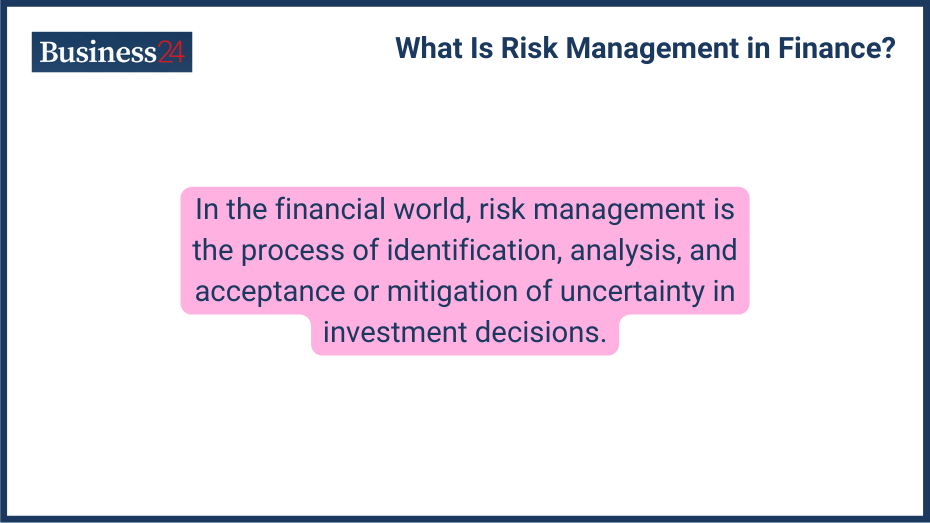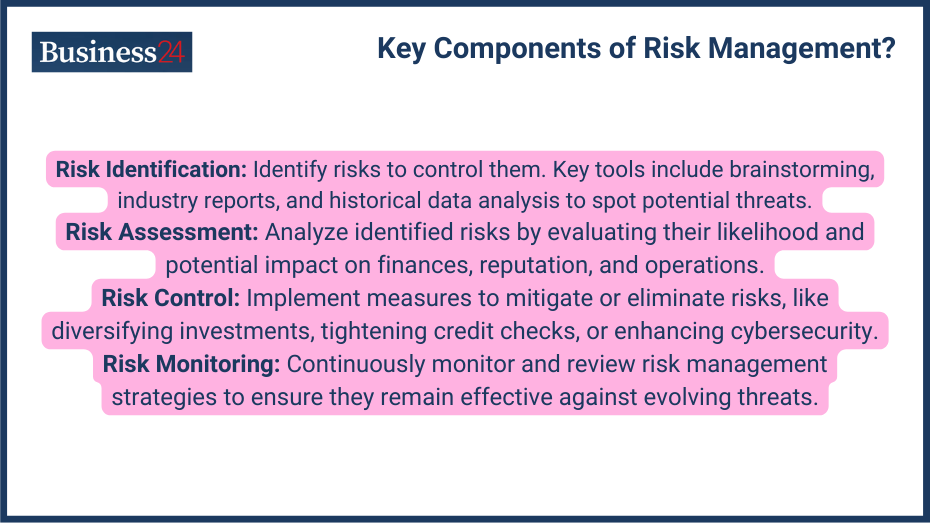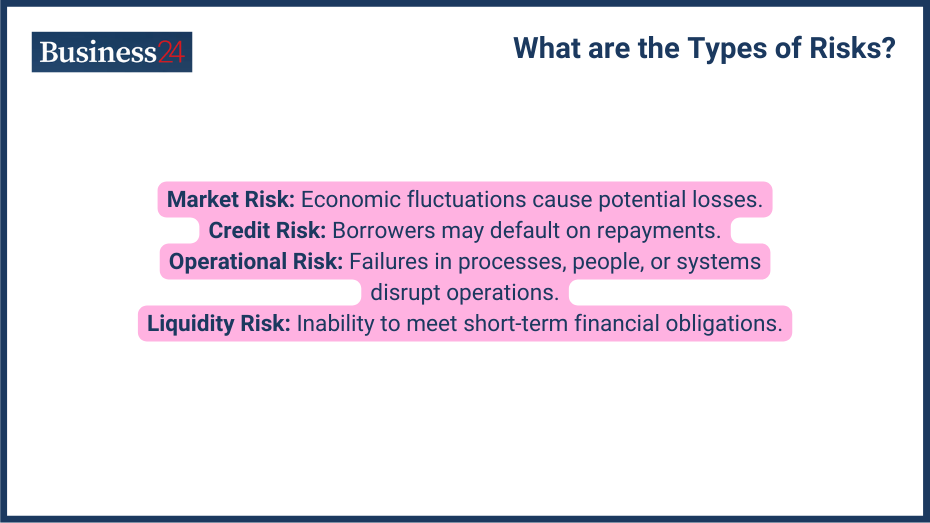
In the financial world, risk management is the process of identification, analysis, and acceptance or mitigation of uncertainty in investment decisions.
There is always some risk in any endeavor; without risk, there is no gain. The important thing is you should know how to manage risk. The capability of managing risk is the top criterion for success in that work.
Risk management is a comprehensive process that teaches you to identify, assess, and prioritize potential threats. Risk management helps you outline coordinated efforts to minimize, control, and monitor the impact of those identified risks. In simple words, risk management is a plan that identifies, assesses, and controls any risk arising.
If you don’t have a risk management plan in place, at the time of emergency, you can’t do anything; forget about stopping an accident; you can’t even control it. The main goal of risk management is to protect your assets and ensure steady growth. By actively reducing potential losses, you create a stronger, more stable foundation for success.
What are the Key Components of Risk Management?

There are four major components in risk management:
- Risk Identification: If you want to control the risk, you have to identify it. Risk identification is one of the most important parts as it tells you about the risk. This involves actively searching for potential threats that could affect your organization. There are various tools for risk identification, like brainstorming sessions, industry reports, and historical data analysis, which can all be valuable tools in this initial stage.
- Risk Assessment: Once you’ve identified potential risks, the next step is to analyze them more thoroughly. This means figuring out how likely each risk is to happen and how serious its consequences could be. Think about different situations and evaluate how each risk could lead to financial losses, harm your reputation, or disrupt your operations.
- Risk Control: Risk control means putting measures in place to lessen or remove these risks. For example, you could diversify investments to reduce market risk, tighten credit checks to minimize credit risk, or set up strong cybersecurity protocols to tackle operational risks. Controlling risk is the main point that prevents accidents.
- Risk Monitoring: After you have applied risk-controlling techniques, continuous monitoring of them is equally important. That’s why it’s crucial to keep an eye on things and regularly check how well your risk management strategies are working. By doing so, you can update and adjust your defenses to stay prepared for any evolving threats.
What are the Types of Risks?

Different working conditions have different types of risk:
- Market Risk: The economy does not remain stable, which affects the markets. And from the fluctuation of the market, different types of risk arise, like changes in stock prices, currency exchange rates, and interest rates; these changes can potentially lead to losses.
- Credit Risk: Little or more, but there is always the risk of default from the borrower, and they might default on their repayment obligations. This risk is particularly relevant in the financial sector but can also impact businesses offering credit to customers.
- Operational Risk: In businesses, operational risk is the biggest risk. These risks come from internal processes, people, or systems failures. Inefficient workflows, human error, or technological glitches can all disrupt operations and lead to a stop of operations.
- Liquidity Risk: You can sometimes face liquidity risk. For example, you have to pay bills but not have immediate access to the necessary funds. Liquidity risk arises from the inability to meet short-term financial obligations.
- Reputational Risk: Reputational risk is one of the risks that, once damaged, can’t fixed and can be detrimental. Negative publicity, product recalls, or data breaches can diminish customer trust and cause sales and brand value to decline.
What is the Risk-Return Tradeoff?
If you have seen Spiderman and heard the quote, “ With great power comes with great responsibility,” you will understand the risk-return tradeoff. Simply put, the risk-return trade-off states that the potential for higher returns often comes from increased risk. Likewise, lower-risk investments typically offer lower potential returns.
You should think about how much risk you can handle and what you want to achieve with your investments. If you aim for big growth, you might be okay with taking more risks. But if keeping your money safe is your main goal, you might prefer investments with lower risk, even if they offer smaller returns.
Understanding the risk-return tradeoff can highly benefit you with your investment goals. For example, if you are a young person you have a lot of time left for retirement; you can go for higher risk because you can create a huge investment return with higher risk. But, if you dont understand the risk-return tradeoff and put your money into a mediocre investment, you will miss big opportunities and time, too.
What is risk vs trade-off?
Risk and trade-off are related but distinct concepts often encountered in decision-making. Risk refers to the potential for an adverse outcome or loss resulting from a particular action or decision. It’s about uncertainty and the possibility that things might not go as planned.
The trade-off, on the other hand, involves balancing competing factors or making compromises. It requires choosing between two or more desirable but incompatible options, recognizing that gaining one benefit might mean sacrificing another. In essence, risk is about the chance of something going wrong, while a trade-off is about making a choice between different benefits and costs.
What are the Strategies for Managing Risk?
There are different risk management strategies applied according to situation requirements:
Risk Avoidance
If a task can done in two ways and one involves completing with risk, but it takes more time, keeping risk control in mind, you choose the second method; sometimes avoiding risk is better than dealing with it. For example, a company might choose not to enter a new market if the political and economic climate is too unstable.
Risk Reduction
Risk reduction is better than risk control; in risk reduction, you focus on minimizing the severity or likelihood of a risk occurring. For example, in a factory, you regularly check machinery, or in a company, audits are done to reduce operational risks.
Risk Sharing
Risk sharing means spreading the risk among several parties. You can do this through insurance, where the insurance company shares the risk of a loss with you, or through partnerships, where you share the risk of a new venture with another company.
Risk Retention
In some cases, accepting a certain level of risk might be the most strategic approach. Risk retention involves budgeting for potential losses and contingency plans to manage the fallout if a risk materializes. For example, a small business might choose to retain the risk of a minor data breach if the cost of implementing extensive cybersecurity measures outweighs the potential losses.
What are the Tools and Techniques in Risk Management?
Here are some of the tools and techniques you can use in risk management:
- Risk Assessment Matrix: This tool helps you prioritize risks by looking at how severe they are and how likely they are to happen. By plotting each risk on a matrix, you can see which ones need the most attention so you can use your resources more effectively to deal with the biggest threats first.
- SWOT Analysis: I think the most popular risk management tool is SWOT analysis.
This strategic planning framework helps assess your Strengths, Weaknesses, Opportunities, and Threats. You can proactively manage risks and capitalize on potential advantages by understanding your internal strengths and weaknesses and the external opportunities and threats you face. - Scenario Analysis: You can think about various risk scenarios for any job or work. Scenario analysis is imagining those different possible future events and their impacts and creating a plan to manage them. You can create backup plans to handle various situations and reduce potential problems by thinking ahead.
How to Implement an Effective Risk Management Plan?
In your risk management plan, you must mention how to implement an effective risk management plan. Here is the step-by-step plan to implement an effective risk management plan:
- Establish a Context: Start with understanding the environment in which your organization or your job operates. Look at things like industry rules, market trends, and what your competitors are doing. This background will help you identify and prioritize risks effectively.
- Risk Assessment: As I mentioned earlier, the first thing to do when constructing an arisk management plan is to identify and assess the risk of potential threats. You can use various mechanical and human tools to do this job.
- Develop Strategies: You have to develop an efficient plan strategy that takes every possible risk into consideration and prepares an efficient plan for effective risk management.
- Implement and Monitor: You must ensure clear communication and accountability for risk management practices across the organization. Regularly monitor the effectiveness of your strategies and adapt them as needed.
What is an example of a trade-off?
Let’s say you are an investor, and you can invest in a high-growth tech startup with the potential for significant returns but also the risk of the company failing. On the other hand, you have the option to invest in a government bond with a guaranteed low return but minimal risk. So, here, the trade-off is between the high-risk high reward and low-risk low reward, and you have to choose between one.
Another real life example could be of a company considering entering a new market might face stricter regulations and higher operational costs compared to their existing markets. The potential for higher profits in the new market would need to be weighed against the increased risks.
What are risk-risk trade-offs?
While “risk-risk trade-off” uses similar terms, it’s not the same as the risk-return trade-off. A risk-risk trade-off refers to situations where you choose between two risks. For instance, you might choose between investing in a company with a higher risk of product failure but a larger potential market or a smaller market but a more established product line.
Educational Resources and Tools
There are various tools for risk management, like root cause analysis, SWOT analysis, probability and impact matrix, etc. With the help of these tools, you can access and make efficient risk management plans.
Specialized risk management software can streamline risk identification, assessment, and monitoring, providing valuable insights and facilitating data-driven decision-making.
Also, there have been a lot of research papers published on risk management, control and prevention, for example, research papers published on risk management by T Johansson and T Aven.
Disclaimer
eToro is a multi-asset platform which offers both investing in stocks and cryptoassets, as well as trading CFDs.
Please note that CFDs are complex instruments and come with a high risk of losing money rapidly due to leverage. 51% of retail investor accounts lose money when trading CFDs with this provider. You should consider whether you understand how CFDs work, and whether you can afford to take the high risk of losing your money
This communication is intended for information and educational purposes only and should not be considered investment advice or investment recommendation. Past performance is not an indication of future results.
Copy Trading does not amount to investment advice. The value of your investments may go up or down. Your capital is at risk.
Don’t invest unless you’re prepared to lose all the money you invest. This is a high-risk investment and you should not expect to be protected if something goes wrong. Take 2 mins to learn more
eToro USA LLC does not offer CFDs and makes no representation and assumes no liability as to the accuracy or completeness of the content of this publication, which has been prepared by our partner utilizing publicly available non-entity specific information about eToro.
